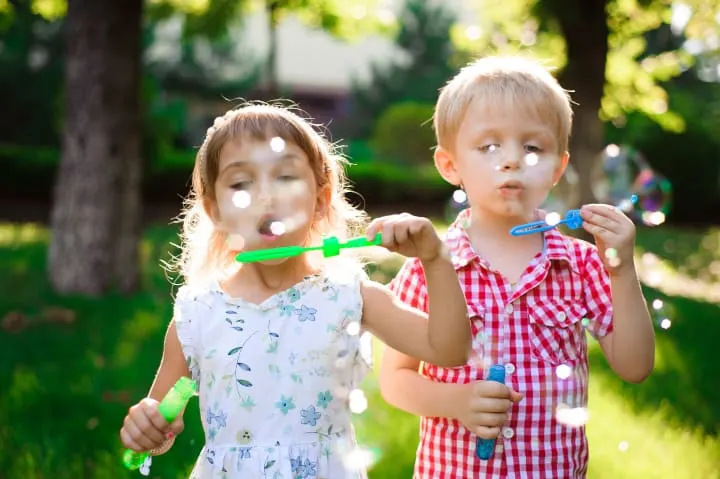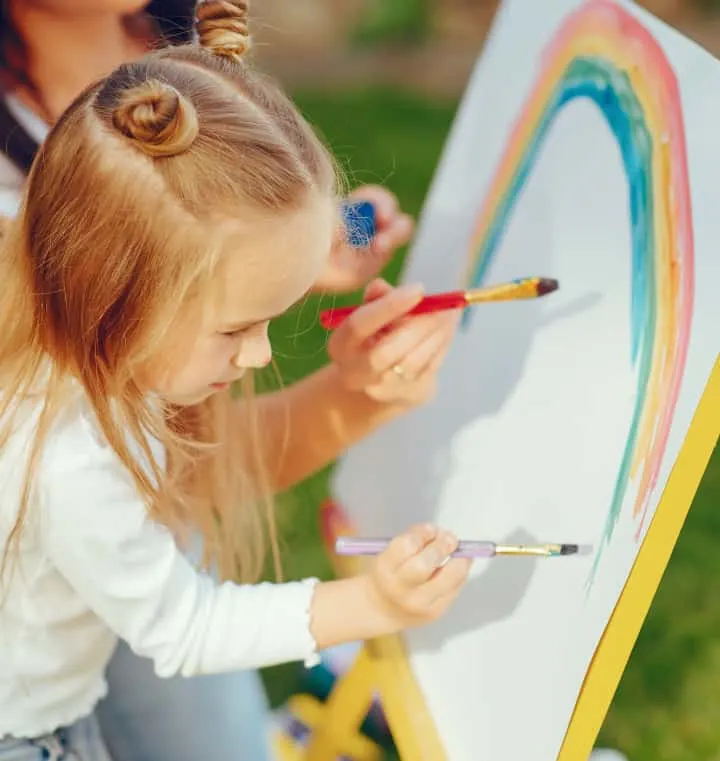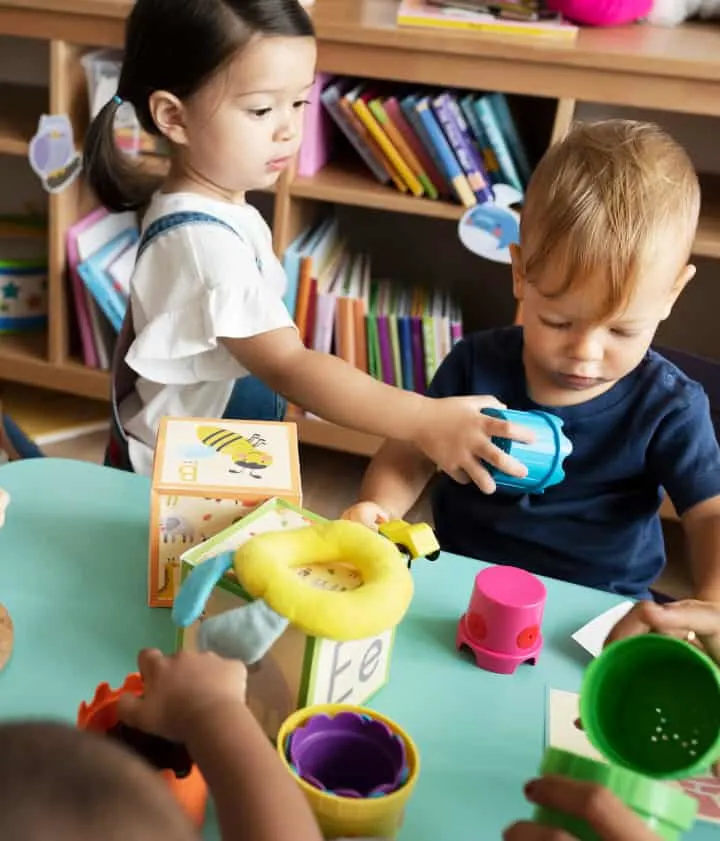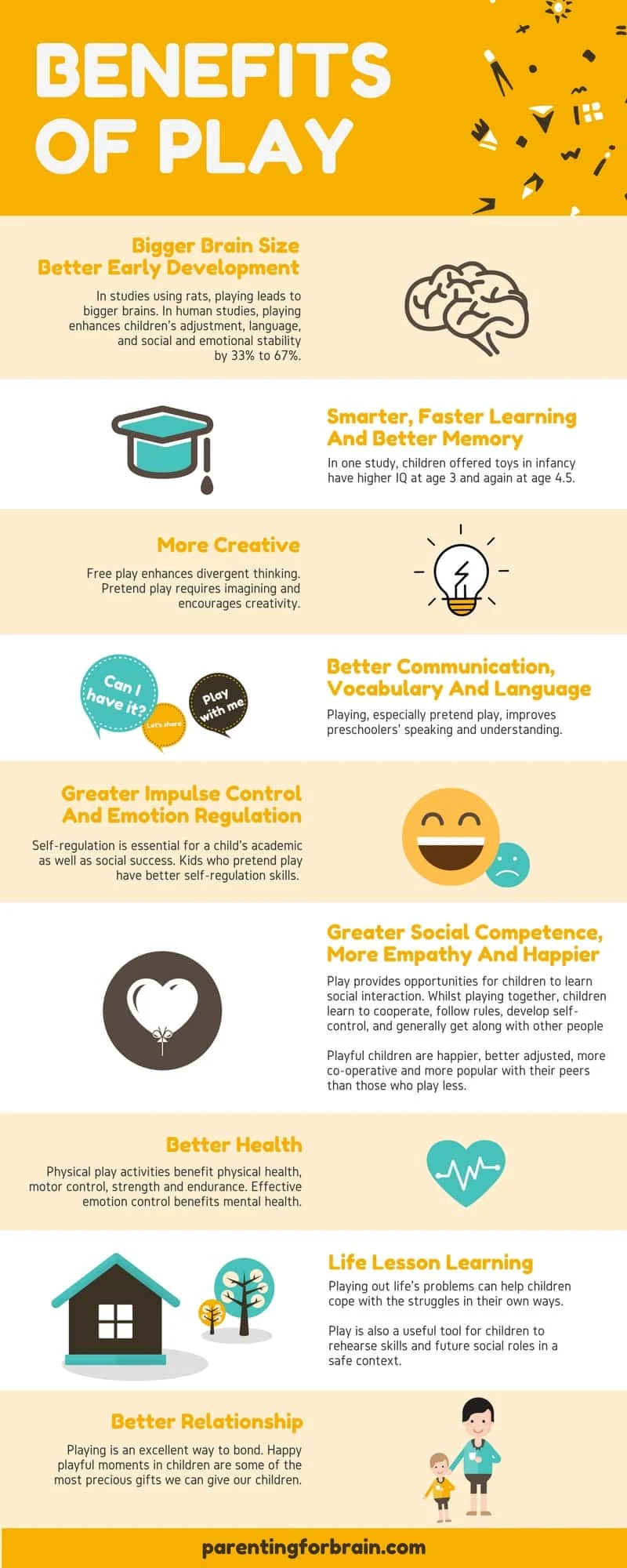In this article, we will look at nine amazing benefits of play in child development. We will also review research results that highlight the importance of children play.
TABLE OF CONTENTS
- Importance of Play in Early Childhood
- 9
Benefits of Play
- 1. Stimulate Early Brain Development
- 2. Improve Intelligence
- 3. Spark Creative Thinking
- 4. Improve Communication, Vocabulary, and Language
- 5. Promote Impulse Control and Emotion Regulation
- 6. Grow Social Competence and Empathy
- 7. Better Physical and Mental Health
- 8. Teach Life Lessons
- 9. Strengthen Relationship with Caretakers and Peers
- References
Importance of Play in Early Childhood
Why is play important for children?
Many parents intuitively know the importance of play in child development, but despite its many benefits, we rarely associate play with learning.
For most people, learning involves acquiring a specific new skill, such as memorizing alphabets, counting, writing, etc. They often believe that playing is only for fun and involves no actual learning.
However, according to studies, playing is learning. Children learn through play experiences.
The importance of play in early childhood education cannot be underestimated because learning through play is essential to a child’s growth.

9 Benefits of Play
1. Stimulate Early Brain Development
Child play can promote brain development in many ways, including providing the child with a better understanding of the world and setting the groundwork for later brain growth1.
At birth, infants’ brains are equipped with an overabundance of brain cell connections (synapses). Synapse overproduction allows information captured from the early years to build a foundation for the brain.
An environment enriched with play, sensory play, and play toys provide the perfect life experiences as building blocks. Lack of play will cause the neuron connections related to play to be lost.
Neuroscientists discovered that enrichment such as toys, games, and playing can alter a brain’s chemistry and the child’s development. The brain area associated with higher cognitive processing (the cerebral cortex) can benefit from environmental enrichment and children’s play more than other parts of the brain2.
2. Improve Intelligence
Early playing also has an important role in a child’s intellectual development.
One study by the University of Arkansas shows that regularly offering toys to infants to play with leads to higher IQ by age three3. Later, psychologist Edward Fisher analyzed 46 studies done on playing. He found that playing could enhance a child’s cognitive, linguistic, and social development4,5.

3. Spark Creative Thinking
Perhaps the most obvious benefit of playing is that it increases a child’s creativity.
Creativity is closely tied to divergent thinking, which is the thought process that explores many possible solutions and generates new ideas. Many studies have found that playing is highly associated with divergent thinking.
To test this association in a study, researchers randomly assigned 52 children, aged six to seven, to two activities. In the first activity, the children copied text from a chalkboard. In the second, the children played with salt-dough6.
Later, all the children were asked to perform a creative project. A panel of ten judges found that the projects created by the children in the salt-dough group had higher creative qualities than those in the other group.
Other studies have also associated free play, especially imaginative play, with significant improvement in divergent thinking7,8.
Free play or independent play is an unstructured form of play that encourages children to design their own play9. Pretend play requires a child to imagine scenarios and then act them out. The freedom of these types of play allows children to be creative10,11.
Imagination fuels creativity and some studies have also found that creative adolescents tend to have had imaginary friends in childhood12.

4. Improve Communication, Vocabulary, and Language
The link between early play and later communication skills is evident in research, too.
One study sought to understand whether communication could benefit from play. Researchers observed what happened when an infant began playing with a toy. They found that if the mother responded by manipulating and naming the toys, the baby – when tested three months later – would have better language skills13.
Another study, conducted by the University of Georgia, observed sixty-five kindergartners in their classrooms over four weeks. The presence of play, especially dramatic play, was found to predict performance in pre-reading, language, and writing14.
Pretend-play is especially beneficial because it allows young children to practice new vocabulary when they speak and try to understand others. During social play, they often reciprocate each other’s words and actions to reach agreements15.
5. Promote Impulse Control and Emotion Regulation
Self-regulation is one of the most important skills for school readiness. Well-regulated children can wait for a turn, resist the temptation to grab objects from other children, control negative emotions, and persist through challenging activities.
In a New Zealand study, psychologists examined how children handled negative events during pretend plays. They found that children who had more pretend plays with their caregivers were better at regulating their emotions to continue playing16,17.
Emotion regulation is not only essential for academic success but also for the psychosocial aspects of child development. It is a strong predictor of a child’s social success18. In preschool, children who exhibit better emotional control are more likable and socially competent19.

6. Grow Social Competence and Empathy
Playing is crucial in enhancing social development in children. Unstructured active play with others – including parents, siblings, and peers – is a significant opportunity to cultivate social skills. While playing, the act of pretending as well as negotiating with peers enhances children’s social skills20.
Playing also provides opportunities for children to learn social interaction. Wehile playing together, children learn to cooperate, follow the rules, develop self-control, and generally get along with other people.
Psychologists found that the amount and complexity of fantasy play by preschoolers significantly predicted their social skills and popularity, as well as their positive social activity21.
Playful children tend to be happier, better adjusted, more co-operative, and more popular with their peers than those who play less.
Children who play more also develop more empathy, another essential element that advances social skills. Such children grow to have a better understanding of other people’s feelings and beliefs.
7. Better Physical and Mental Health
We already know that play promotes a child’s emotional development. Emotional intelligence is vital for a child’s resilience and mental health.
Playing that involves physical activities also promotes gross motor skills, strength, endurance, and physical health.
8. Teach Life Lessons
Play helps children develop problem solving skills.
When children act out life’s problems in pretend-playing, it helps them cope with the struggles in their own ways. It also provides a safe opportunity for children to rehearse skills and future social roles.
When children try out various roles, they learn to take on different perspectives, which will further assist them in abstract thinking22.
Also See: Parten’s 6 Social Stages of Play and Why They Are Important

9. Strengthen Relationship with Caretakers and Peers
Parents who play with their children form a stronger bond with them. Even simple games like scavenger hunts can become a special bonding moment for both parents and children. These interactions provide positive life experiences that stimulate children’s brain development.
Last but not least, happy, playful moments are some of the most precious gifts we can give our children.
Final Thoughts on Play
Because play is imperative in a child’s development, play-based preschools may provide a better learning environment than other alternatives23. When choosing a preschool, parents should pay attention to how classes are conducted, whether the “play to learn” approach is used, and how much free-play is allowed. Creating a Montessori home is also a good alternative.

References
- 1.Rosenzweig M, Bennett E. Psychobiology of plasticity: effects of training and experience on brain and behavior. Behav Brain Res. 1996;78(1):57-65. https://www.ncbi.nlm.nih.gov/pubmed/8793038.
- 2.Diamond M. Response of the brain to enrichment. An Acad Bras Cienc. 2001;73(2):211-220. https://www.ncbi.nlm.nih.gov/pubmed/11404783.
- 3.Elardo R, Bradley R, Caldwell BM. The Relation of Infants’ Home Environments to Mental Test Performance from Six to Thirty-Six Months: A Longitudinal Analysis. Child Development. March 1975:71. doi:10.2307/1128835
- 4.Bergen D. The Role of Pretend Play in Children’s Cognitive Development. Early Childhood Research & Practice. 2002;4(1).
- 5.Fisher EP. The impact of play on development: A meta-analysis. Play & Culture. 1992;5(2):159-181.
- 6.Howard-Jones P, Taylor J, Sutton L. The Effect of Play on the Creativity of Young Children During Subsequent Activity. Early Child Development and Care. August 2002:323-328. doi:10.1080/03004430212722
- 7.Holmes RM, Romeo L. Gender, play, language, and creativity in preschoolers. Early Child Development and Care. November 2013:1531-1543. doi:10.1080/03004430.2012.733381
- 8.Russ SW, Wallace CE. Pretend play and creative processes. American Journal of Play. 2013;6(1):136-148.
- 9.Burdette HL, Whitaker RC. Resurrecting Free Play in Young Children. Arch Pediatr Adolesc Med. January 2005:46. doi:10.1001/archpedi.159.1.46
- 10.Dansky JL. Make-Believe: A Mediator of the Relationship between Play and Associative Fluency. Child Development. June 1980:576. doi:10.2307/1129296
- 11.Dansky JL, Silverman IW. Effects of play on associative fluency in preschool-aged children. Developmental Psychology. 1973:38-43. doi:10.1037/h0035076
- 12.Schaefer CE. Imaginary companions and creative adolescents. Developmental Psychology. 1969:747-749. doi:10.1037/h0028270
- 13.Newland LA, Roggman LA, Boyce LK. The development of social toy play and language in infancy☆ 3 3☆ This research was funded by a University Faculty Grant to Lori Roggman from the Vice President for Research at Utah State University, 1990–1992, by a College of Family Research Grant to Lori Roggman, 1998–2000, by a Fellowship to Lisa Newland from the Vice President for Research at Utah State University, 1997–1998, and by a College of Family Life Fellowship to Lisa Newland, 1998–2000. Infant Behavior and Development. January 2001:1-25. doi:10.1016/s0163-6383(01)00067-4
- 14.Pellegrini AD. The relationship between kindergartners’ play and achievement in prereading, language, and writing. Psychol Schs. October 1980:530-535. https://eric.ed.gov/?id=ej236155.
- 15.Lewis V, Boucher J, Lupton L, Watson S. Relationships between symbolic play, functional play, verbal and non-verbal ability in young children. Int J Lang Commun Disord. 2000;35(1):117-127. https://www.ncbi.nlm.nih.gov/pubmed/10824228.
- 16.Galyer KT, Evans IM. Pretend Play and the Development of Emotion Regulation in Preschool Children. Early Child Development and Care. January 2001:93-108. doi:10.1080/0300443011660108
- 17.Hoffmann J, Russ S. Pretend play, creativity, and emotion regulation in children. Psychology of Aesthetics, Creativity, and the Arts. May 2012:175-184. doi:10.1037/a0026299
- 18.Denham S, Blair K, DeMulder E, et al. Preschool emotional competence: pathway to social competence? Child Dev. 2003;74(1):238-256. https://www.ncbi.nlm.nih.gov/pubmed/12625448.
- 19.Mayberry ML, Espelage DL. Associations Among Empathy, Social Competence, & Reactive/Proactive Aggression Subtypes. J Youth Adolescence. July 2006:787-798. doi:10.1007/s10964-006-9113-y
- 20.Doyle A-B, Connolly J. Negotiation and enactment in social pretend play: Relations to social acceptance and social cognition. Early Childhood Research Quarterly. September 1989:289-302. doi:10.1016/0885-2006(89)90015-x
- 21.Connolly JA, Doyle A-B. Relation of social fantasy play to social competence in preschoolers. Developmental Psychology. 1984:797-806. doi:10.1037/0012-1649.20.5.797
- 22.Youngblade LM, Dunn J. Individual Differences in Young Children’s Pretend Play with Mother and Sibling: Links to Relationships and Understanding of Other People’s Feelings and Beliefs. Child Development. October 1995:1472. doi:10.2307/1131658
- 23.Diamond A, Barnett WS, Thomas J, Munro S. THE EARLY YEARS: Preschool Program Improves Cognitive Control. Science. November 2007:1387-1388. doi:10.1126/science.1151148
